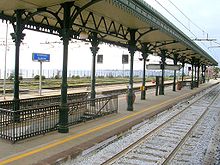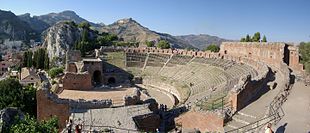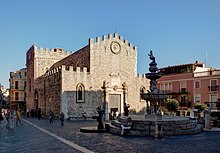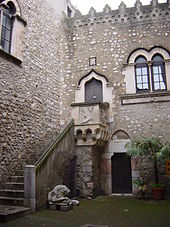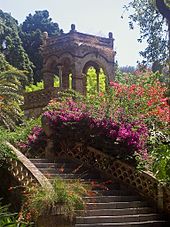Taormina
| Taormina | ||
|---|---|---|

|
|
|
| Country | Italy | |
| region | Sicily | |
| Metropolitan city | Messina (ME) | |
| Local name | Taurmina | |
| Coordinates | 37 ° 51 ' N , 15 ° 17' E | |
| height | 204 m slm | |
| surface | 13 km² | |
| Residents | 10,844 (Dec. 31, 2019) | |
| Population density | 834 inhabitants / km² | |
| Factions | Mazzeo , Trappitello | |
| Post Code | 98039 | |
| prefix | 0942 | |
| ISTAT number | 083097 | |
| Popular name | Taorminesi | |
| Patron saint | San Pancrazio | |
| Website | Taormina | |
Taormina ( Sicilian : Taurmina) is a city with 10,844 inhabitants (as of December 31, 2019) on the east coast of Sicily . The founding of the city goes back to the Sikelers , who settled on the terraces of Monte Tauro even before the Greek colonization . In the 4th century BC The city became Greek . The current city is a re-establishment from the Middle Ages after the Arabs destroyed the ancient city.
Due to the picturesque landscape, the mild climate and numerous historical sights, the city developed into one of the most important tourist centers in Sicily in the 19th and 20th centuries. The ancient theater with a view of Mount Etna and the Gulf of Giardini-Naxos and the small island of Isola Bella off the coast of Taormina are particularly well-known and worth seeing .
Location and climate
Taormina is located in the Italian metropolitan city of Messina in the autonomous region of Sicily , about 40 kilometers northeast of Mount Etna on the Ionian Sea between Messina and Catania . The original town center was built on a terrace of Monte Tauro about 200 m above sea level. Today the urban area extends to the sea.
The neighboring municipalities of the city are Calatabiano , Castelmola , Castiglione di Sicilia , Gaggi , Giardini-Naxos and Letojanni . Taormina is 45 km away from Messina and 57 km from Catania.
The Mediterranean climate is particularly mild here on the east coast of Sicily. In January and February the average temperatures are 14 ° C, in July and August 28 ° C to 33 ° C. The average water temperature is 16 ° C in winter and 28 ° C in summer. The rainiest months are November and December.
Districts
In addition to the main town located on Monte Tauro, some places by the sea and in the valley belong to the municipality of Taormina. Mazzarò, Villagonia and Mazzeo are the seaside districts of Taormina, Trappitello is about 2 km inland in the Alcantara Valley.
Mazzarò
The fastest way to overcome the difference in altitude between the old town and Mazzarò is to take a cable car. It only takes a few minutes and offers a view of Castelmola and the bay of Letojanni .
The beaches of Taormina are located in two small bays. Excursion boats offer the opportunity to go from here to the neighboring towns of Letojanni and Giardini-Naxos. The main attraction for tourists in Mazzarò is Isola Bella , a small island that is connected to the beach by a sandbank. It has been under nature protection since 1998, as rare species of plants and birds can be observed here. South of the bathing bays of Mazzarò is the Capo Taormina, a promontory jutting out into the sea.
Trappitello
The Trappitello district is in the immediate vicinity of Giardini Naxos . Many of the non-tourism businesses are centered in this district, as it is better suited for them than the narrow main town and also because Trappitello is close to a motorway exit.
population
Taormina has 10,844 inhabitants (as of December 31, 2019) and is one of the most populous and densely populated communities in the metropolitan city of Messina .
Most of the population belongs to the Roman Catholic Church . There is also an Anglican church that was founded by English settlers in the wake of the Duke of Bronte appointed Lord Nelson had come to Sicily. Their church of Saint George is also used by the Evangelical Lutheran Church for worship services.
The Sicilian language is cultivated especially among the elderly .
history
Around 1300 BC The Sikeler , who gave the island of Sicily its name, settled on the slopes of Monte Tauro. The inhabitants maintained good relations with the Greeks of 735 BC. BC very near founded city Naxos . After the destruction of Naxos by Dionysius I of Syracuse , they took its inhabitants into their city. The Greeks called the city Tauromenion , and in 358 BC With Andromachos, the father of the historian Timaeus , a Greek became ruler of the city for the first time.
When Sicily in the 3rd century BC After the First Punic War became a Roman province after the First Punic War , Tauromenion became Latin Tauromenium , and high officials from Rome had houses built here for their families in the style of Roman town villas. The city was equipped with large water reservoirs by the Romans so that it could withstand long sieges. Since Tauromenium after the assassination of Gaius Julius Caesar to Sextus Pompey against the second triumvirate had supported, let Octavian v after his victory over Sextus Pompey 36th Deport the residents.
When Sicily was conquered by the Saracens , Tauromenium was able to withstand the attacks for a long time thanks to its protected location and its water reservoirs, and after the fall of Syracuse it became the center of the part of Sicily, which was still ruled by Byzantines . When the Byzantine general Nikephoros Phokas and his soldiers were ordered back to Constantinople, the tide turned. On August 1, 902 the place was conquered by a force of the Aghlabid emir Abū Ishāq Ibrāhīm II . After two revolts against Arab rule in 962 and 969, the city was destroyed. It was not settled again until the 13th century, but could never achieve its former importance. Especially after an uprising against Spanish rule in 1674–1678, the situation of Taormina deteriorated more and more, and when the Messina – Syracuse road was moved to the coast in the 18th century and no longer ran through Taormina, the city sank into an insignificant village . Taormina only experienced an economic boom again through tourism.
tourism
One of the first tourists to Taormina was Johann Wolfgang von Goethe in 1787 , who visited the place in the company of Christoph Heinrich Kniep and dedicated a few pages in his Italian journey to him.
Tourism began to flourish towards the end of the 19th century. The painter Otto Geleng made the place known far beyond Sicily with his landscapes of Taormina and the surrounding area. Wilhelm von Gloeden's photographs also attracted attention . Geleng and von Gloeden attracted other artists such as Oscar Wilde , D. H. Lawrence , Thomas Mann and Richard Strauss .
Thanks to the mild climate, Taormina became a popular winter destination for European nobles, e. B. of the German Emperor Wilhelm II. On the occasion of the visit of the Austrian Empress Elisabeth , the Taormina-Giardini station, which was set up in 1866, was considerably expanded and the main building, which still exists today, was given in Art Nouveau style. Many guests stayed for weeks or months and contributed to the economic growth. The first large hotels were opened.
In the middle of the 20th century, Taormina became a popular resort for film stars such as Greta Garbo , Marlene Dietrich , Cary Grant , Elizabeth Taylor and many others on the occasion of the Taormina Arte festival, which takes place every year to this day . The main travel season therefore shifted from winter to summer.
Today the city is a year-round destination for tour groups and day tourists from all over the world.
economy
The main occupations in Taormina are services and tourism . In 2005 the city administration registered 1.3 million visitors. In addition to 60 upper and middle class hotels, small guesthouses are increasingly offering accommodation. In the city center there is a large number of gastronomic businesses and most of the shops have switched to tourism and offer souvenirs and Sicilian delicacies.
Another line of business is the production of Vino di Mandorla , an almond wine that is typical of Taormina and the neighboring municipality of Castelmola.
traffic
The place is easily accessible for travelers via the A18 Messina – Catania motorway and the Messina – Catania railway line operated by Trenitalia . The international airport Fontanarossa is located in Catania , from Messina there are daily ferries to the Italian mainland.
The Taormina train station (officially called Taormina-Giardini ) is located in the Villagonia district, a few meters from the coast. City buses or, alternatively, a cable car run from the old town to the districts by the sea.
The old town itself is traffic-calmed, but has two large parking garages for visitors: the Porta Catania car park and the Lumbi car park . In winter, when fewer tourists come to Taormina, the latter partly serves as a venue for trade fairs and exhibitions. In summer it offers space for 965 cars and 40 buses. There is a parking space for around ten mobile homes on the road that leads up from the campsite to the old town.
Due to the increasing costs for street cleaning and garbage disposal, which are mainly caused by tourism, the city administration has decided to charge an additional fee for the use of the city parking lots. Since June 2006, an “environmental fee ” of one euro for cars, 10 euros for minibuses and 40 euros for coaches has been charged.
education
The “Istituto Comprensivo Ugo Foscolo ”, named after an Italian poet, has around 600 students. The school became an integrated school as a result of the 2003 Italian school reform. Kindergarten, elementary and middle school are now housed in one building. The elementary level comprises five school years and English is taught as the first foreign language. The intermediate level ends after three years with a final examination. As there is great interest in the German language in Taormina due to tourism, a vote was taken to offer German as a second foreign language in addition to French.
There is also a school for the Catholic Marist School Brothers ("S. Maria di Gesù redentore"). This offers lessons in the middle and upper level (humanistic grammar school). Here, too, English is now taught throughout, and German is also taught in the intermediate level.
The "Liceo Linguistico Ferdinando de Saussure" is a grammar school specializing in foreign languages. Accordingly, in addition to English, French and German are compulsory.
The “Istituto Tecnico Commerciale e per il Turismo” S. Pugliatti '”, which offers various specializations for around 900 students. In addition to access to university studies, graduates receive training in the areas of accounting, administration, marketing or tourism.
Events
Taormina is known for the particularly colorful carnival parades in February. From the end of April to the end of May there is a regular festival of the Sicilian carts . On July 9, there are parades in honor of San Pancrazio, the patron saint of Taormina.
From 1956 to 1980 the David di Donatello , the most important film award in Italy, was awarded in Taormina with a few exceptions. Based on this, the Taormina Arte Festival takes place every year in the summer months with performances of plays and classical and modern concerts. In this context, an annual film festival takes place, which is intended to tie in with Taormina's tradition as a festival location, but has lost its importance compared to other film festivals.
Taormina has a convention center in the city center where political, cultural and scientific conferences are held. In February 2006 NATO met in Taormina. The G7 summit 2017 took place on 26./27. May 2017 in Taormina.
Buildings and cityscape
Ancient theater
The ancient theater of Taormina is the second largest in Sicily after that of Syracuse . Although it is often referred to as the Teatro Greco , it is a Roman structure dating from the 2nd century BC. Over a smaller one, used by the Greeks in the 3rd century BC. Built theater was built. When it was converted into an arena in the 2nd century AD, the auditorium was again considerably expanded. While the theater was originally used to stage plays, only gladiatorial and animal fights took place there after this renovation.
The theater measures 120 m in length, 50 m in width and 20 m in height, faces south-west and is divided into the areas of stage, orchestra and grandstand (cavea). As it was built on top of an older Greek theater, it is embedded in the hillside, while Roman theaters were otherwise free-standing structures. The steps of the grandstand were partly cut into the existing rock and even then offered space for around 5400 spectators. The lowest step has a radius of 62 m, the top one of 147 m.
The stage building was built from brick in Roman times. On the spectator side, it shows a two-story façade with niches in which statues stood and columns in front. Partly destroyed by wars, the stage building was partially restored in the 19th century. An opening about ten meters wide gives a view of Mount Etna and the bay of Giardini-Naxos .
Next to the theater is the Antiquarium , a small archaeological museum. Although most of the archaeological finds are on display in the museums of Naples , Messina, and Syracuse , there are a few exhibits here that are worth seeing. Interesting, among other things, is a marble plinth with an inscription that says that Tauromenion achieved a horse racing title at the ancient Olympic Games .
Odeon
The Odeon is another theater that was built during the Roman Empire . The layout is similar to the Greek theater, but is considerably smaller and oriented to the northeast. It was built against the long side of a Greek temple that served as the rear wall of the stage.
Archaeologists suspect that the Odeon was reserved for a limited, select audience such as high officials, clergy and guests of honor and that not only theater performances but also lectures and discussions took place here. The remains of the Odeon were discovered by chance during construction work in 1892.
Churches
The Dom San Nicolò , also known as the fortress cathedral , is located in the center of Taormina and was built in the 15th century on the ruins of a smaller church from the early Middle Ages. The building consists of a main aisle and two side aisles, each with three small altars. Noteworthy are a Byzantine Madonna, a painting by Antonio Giuffrè depicting the Visitation of Mary and a polyptych by Antonello de Saliba . The main portal of the cathedral and the chiseled rose window above it were renewed in 1638 in the Renaissance style.
In the square in front of the cathedral there is a baroque fountain built in 1635 with two water basins one above the other. The Centauressa , a figure similar to the Greek Centaurs , is enthroned above it . The bull's body symbolizes the mountain Monte Tauro, the female body with scepter and globe the city of Tauromenion. The Centauressa, the city's official landmark , is also shown in the city's coat of arms.
The church of Sant'Agostino , like the cathedral, was built in the 15th century. The occasion was the relief and gratitude of the population, as Taormina had been spared a plague epidemic. The late Gothic style was lost due to a major renovation around 1700 . Only the portal and the rose window remain from the old facade. Today the community library is housed in the building.
The holy martyr Pancras is the patron saint of Taormina. In his honor, the church of San Pancrazio was built in the second half of the 16th century on the ruins of a Greek temple . It shows elements of the Baroque and houses two oil paintings that are worth seeing, showing Saint Nicone and Saint Massimo. A wall fresco depicts Teofane Cevarneo, Bishop of Taormina.
Two more churches were built in the 17th century. The Church of San Giuseppe opposite the Municipal Library (Sant'Agostino) and the Church of Santa Caterina near the Odeon. It houses a large statue of Saint Catherine of Alexandria in a niche above the portal . Inside there is a crypt and the ossuary.
The Anglican Church of Saint George was built in 1920 by the Anglican congregation. The interior is divided into two naves by three arches resting on columns. The multi-colored glass window above the altar depicts the crucifixion of Jesus .
Palaces
The Palazzo Corvaja bears the name of one of the oldest noble families in the city and shows stylistic features of the Sicilian Romanesque, a mixture of Arabic-Byzantine-Norman style elements. The centerpiece of the palace is a square tower from the 11th century, the only surviving example of an Arab fortress tower in Europe. It was built on the model of the Kaaba in Mecca when the defenses were expanded. In the 13th century the tower was enlarged by the left wing, and in the 14th century the entrance stairs to the first floor were built. On the balustrade of the landing there is a high stone relief that depicts creation, the fall of man and the expulsion from paradise. In the 15th century the right wing, where the Sicilian parliament met, was added. After the Second World War, the palace was in a neglected state. It was extensively renovated and received another wing in 1960, which now houses the offices of the spa administration.
The Palazzo Duchi di Santo Stefano was the residence of the Spanish noble family De Spucches , dukes of Santo Stefano. It was built in the 14th century and features elements of the Sicilian Romanesque and Gothic. A frieze of black lava and white Syracuse rock along the roof edge is characteristic of the building . Above the Gothic, two-part windows there are rosettes with a hexagram , in the Middle Ages a symbol of defense against demons and the danger of fire. The palace suffered severe damage during World War II. It became the property of the municipality in the 1960s and has been restored. Today the Mazzullo Foundation is located here, showing works by the sculptor Giuseppe Mazzullo .
The Palazzo Badia Vecchia was probably an abbey in the beginning . It was also built in the 14th century and is very similar in style to the Palazzo Duca di Santo Stefano. Above each of the three floors there is an artistic frieze made of lava and Syracuse rock on the facade. The frames of the Gothic double windows are also decorated with black and white ornaments. The palace has been owned by the municipality of Taormina since the 1960s. In 1995, a small museum with archaeological finds from private collections was opened in Badia Vecchia.
The Palazzo Ciampoli is the oldest palace in Taormina and is therefore also called Palazzo Vecchio. It dates from the 13th century and was rebuilt and expanded in the 15th century. On a plaque above the main portal, the year 1412 is given as the start of the renovation. Two other coats of arms suggest that the palace was first owned by the Corvaja family, then the Ciampoli family. In 1926, due to the growing tourism, a luxurious hotel was built in the spacious garden of the palace. Palace and hotel were almost completely destroyed in 1943. Only the main facade and the portal were rebuilt.
Corso Umberto
In ancient times Taormina was secured by a triple fastening ring. Two city gates from this period have been preserved, which are now in the center of the city. The northern gate, Porta Messina , was restored by the Bourbons in the early 19th century. The Porta Catania in the south was restored under the rule of the kings of Aragon in the 15th century and shows their family coat of arms. Corso Umberto, a pedestrian zone about one kilometer long, runs between these two city gates . During the summer months mainly tourists are on the move, as many of the historic churches and palaces are located along the street in addition to souvenir shops, restaurants and cafés.
Piazza IX is roughly in the middle of Corso Umberto . Aprile , a large square open to the sea. In addition to the Church of San Agostino, there is another Taormina landmark, the Torre dell'Orologio . The tower originally dates from the 12th century and served as a gateway to the suburb. During a restoration in the 17th century, a large clock was installed that gives the tower its name.
Between Piazza IX. Aprile and Porta Messina, Corso Umberto is lined with a blind facade over 100 m long, the so-called naumachie . It has alternating arched niches and smaller, higher-lying rectangular niches. This wall got the name Naumachie because it was thought to be a side wall of a water basin for re-enactments of sea battles. Presumably, however, it only served to support an embankment.
city Park
Between Corso Umberto and the ancient theater, a little lower down on the slope, is Taormina City Park, a public garden, hence also called Giardino Pubblico . The approximately three hectare site belonged to members of the small English community, who created an artfully decorated English park here towards the end of the 19th century . A member of this community, Florence Trevelyan, also purchased Isola Bella and grew exotic plants for the park there. The park was opened to the public around 1920.
In the park, paths with patterns made of pebbles lead between the beds, bordered by low hedges made of bougainvillea and rosemary . Tree species from all over the world are represented here. In the midst of the lush, Mediterranean planting there are small temples and sculptures as well as some brick buildings in the Victorian style that Florence Trevelyn had built for bird watching. A war memorial commemorates the fallen of the two world wars. An avenue of olive trees was also planted in honor of the fallen soldiers.
Surroundings
The Castello Sarazeno and the pilgrimage church Madonna della Rocca were built in 1640 and are located on a rocky plateau between Taormina and Castelmola.
The small town of Castelmola on the summit of Monte Tauro offers a view of Taormina and Mount Etna in addition to some historical buildings.
In Giardini-Naxos, excavations and finds from Naxos , the first Greek settlement in Sicily, can be viewed in an archaeological park and a museum .
The up to 20 meters deep canyons of the Gole dell'Alcantara were carved into the lava rock of Etna by the Alcantara river . The Parco dell'Etna regional park stretches around the Etna volcano with its typical flora and fauna.
Personalities
Sons and daughters
Around 345 BC Chr. Was Timaeus , was born a historian in ancient Tauromenion. Legend has it that Pancratius of Taormina , the city's patron saint, died here around 40 AD .
People related to the city
Jim Kerr , singer of the band Simple Minds , made Taormina his second home. He owns the Hotel Villa Angela there and is the owner of the local association AC Celtic Taormina.
literature
- Lanfranco Angeli: Taormina. Pearl of the Mediterranean. F.lli Mistretta, Palermo 1988.
Web links
Individual evidence
- ↑ Statistiche demografiche ISTAT. Monthly population statistics of the Istituto Nazionale di Statistica , as of December 31 of 2019.
- ↑ Nikephoros Phokas at medieval-genealogie.de , queried on August 1, 2010
- ↑ Third-Millennium-Library.com: The struggle with the Saracens (867-1057) ( Memento of March 6, 2011 in the Internet Archive ) (English), accessed on August 1, 2010
- ^ Italian trip: Taormina
- ↑ Taormina in Sicily: orange tree in front of Etna. In: Spiegel Online . September 22, 2004, accessed June 9, 2018 .
- ↑ Description of the congress center
- ↑ Jim Kerr's hotel website ( Memento from July 26, 2009 in the Internet Archive )





